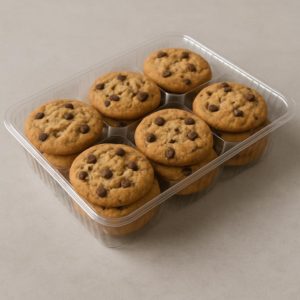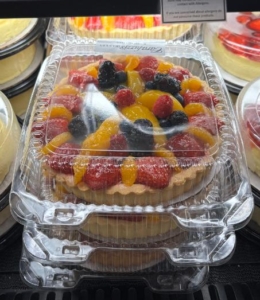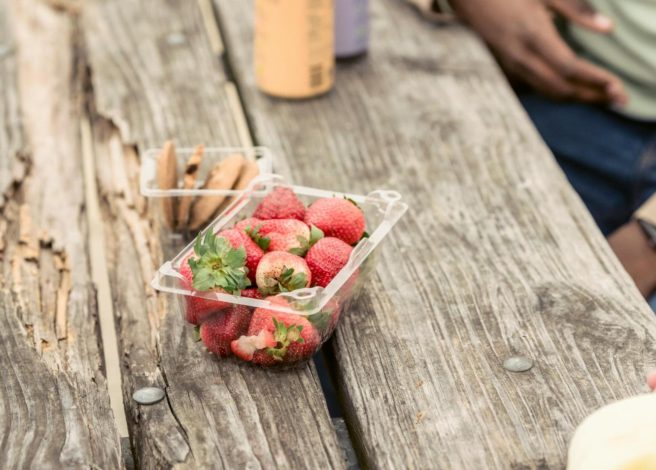At a Glance
- OPS packaging is disappearing from shelves due to limited recyclability, heat sensitivity, and shrinking supply — despite its clarity and low cost.
- PET took the lead with better durability, barrier properties, and widespread recyclability, making it the go-to for modern food packaging.
- Sustainability matters: OPS (#6) has little recycling support, while PET (#1) aligns with both consumer expectations and environmental goals.
- Now’s the time to plan: OPS is still available, but smart businesses are already shifting to PET before supply and costs become a problem.
If you’re a food industry professional, you’ve likely noticed Oriented Polystyrene (OPS) containers becoming increasingly rare on shelves. In fact, many of you may be asking, “What on Earth is OPS packaging?” OPS is a type of rigid, transparent plastic often used for bakery and deli packaging because of its clarity and low cost.
The packaging material that used to dominate bakery goods and food service is fading away. This change has been happening for the last twenty years, and there are several reasons why.
This week, we spoke with Conor Carlin, President of Clefs Advisory LLC. Working at the intersection of packaging and sustainability, Conor held the role of President for the Society of Plastics Engineers in 2024 and previously served as General Manager for ILLIG in North America. His knowledge encompasses materials, packaging technologies, policy, commercial strategy, and market intelligence.
This article will explain why OPS fell behind options like PET, look at recycling challenges that hurt polystyrene packaging, and offer insights into this big change in the industry. You’ll discover not just what happened to OPS but also why smart food industry leaders shifted away from this once-beloved material before it became the packaging equivalent of a flip phone.
What Makes OPS Special (And Why It’s Fading Away)
Think of OPS as the cousin of regular polystyrene — they’re from the same plastic family, but OPS got the special treatment. The “oriented” part means the plastic molecules were stretched and lined up during manufacturing. It’s like combing hair all in the same direction. This gives OPS its crystal-clear look and extra strength. Another distinct material advantage of OPS is its relatively low density, or specific gravity, which translates to higher yields during the manufacturing process. When you combine the strength from orientation and the low density, you get a very efficient and cost-effective material.

Image created using AI.
You can spot OPS containers easily: today, you might see them as rigid cookie trays in packaging or as the lids on aluminum food trays when you order takeout (many businesses use a layered paper product for these lids now). They’re clear and make a unique “ping” when you flick them. You should try it next time! They look like most other plastic food packaging today (more on this to come). They do have one odd weakness: they really dislike heat. Here’s why: remember how those molecules were stretched and aligned? Heat makes them want to return to their original, relaxed position. It’s like a rubber band stretched for too long — give it some warmth, and it contracts back with a vengeance. Heat can shrink OPS to a fraction of its original size. This is a big problem for food packaging.
The Thermoforming Advantage
OPS is interesting in this way: while too much heat causes shrinkage, controlled heat during thermoforming (the formation of plastic products using heat) is where OPS shines. This shrinkage tendency works in the material’s favor during the manufacturing process. The heated OPS contracts and easily separates from the forming equipment when it cools, resulting in the perfectly shaped containers you see in bakeries and delis.
Think of it like a perfectly fitted glove that loosens just enough to slip off easily. Manufacturers adapted to OPS’s shrinking nature instead of resisting it by tweaking the extrusion process — things like temperature, pressure, and “extruder screw speed” (yes, that’s a real thing, not the name of a garage band). They paired that with contact-heat thermoforming machines designed specifically for this feature. The controlled shrinkage became a feature, not a bug.
The Market Forces Working Against OPS
So, if OPS had such great thermoforming properties, what went wrong? Several powerful market forces converged to push this once-popular material toward the sidelines.
The Superior Performance of Another Material: PET
 The biggest challenge facing OPS isn’t just competition — it’s being outperformed. PET (polyethylene terephthalate) entered the market and was suddenly the cool new kid in town with the fanciest sneakers.
The biggest challenge facing OPS isn’t just competition — it’s being outperformed. PET (polyethylene terephthalate) entered the market and was suddenly the cool new kid in town with the fanciest sneakers.
PET offers superior barrier properties that OPS can’t match. OPS offers good clarity and formability. However, PET provides superior moisture barriers, oxygen barriers, and impact resistance. (That’s right. OPS can easily crack. Even at ambient temperatures.)
This means longer shelf life, improved product protection, and happier customers for food business pros. When you have to choose between basic protection and a material that keeps your product fresh longer, it’s an easy decision.
The Recycling Reality Check
Here’s where things get complicated for OPS. Like all polystyrene types, OPS has resin code #6. But the truth is tough: there’s almost no market for recycled polystyrene.
OPS containers don’t flow smoothly like PET bottles. Instead, they often end up in “3-7 bales.” This mixed plastic category is tough for many facilities to process profitably. MRFs (Material Recovery Facilities, where items are sorted after consumer use) rarely sort for #6 plastics because there’s little to no demand for recycled output.
This creates a sustainability problem that forward-thinking food companies can’t ignore. Major polystyrene manufacturers tried to set up recycling programs. They added drop-off locations nationwide, but the costs didn’t add up. These programs made consumers drive far to drop off materials, making them hard to use widely.
Environmental and Health Concerns
OPS’s main ingredient, styrene, has a bad reputation for health concerns. But the same chemical is found naturally in strawberries. Scientists know that tiny amounts of most chemicals are harmless — it’s all about how much you’re exposed to — after all, “The dose makes the poison.” But when people hear “chemical,” they often worry regardless of the science.
Also, styrene comes from oil and gas processing. This gives it a disadvantage in today’s eco-friendly market. Materials linked to fossil fuels struggle for acceptance in society, including PET. The difference is that PET is widely accepted in recycling. OPS, however, does not share this support.
The Path Forward: What This Means for Your Business
Understanding why OPS fell out of favor is one thing — knowing how to navigate the current packaging landscape is another. Here’s your practical game plan.
Short-Term Strategies
If you’re currently using OPS packaging, you don’t need to panic and switch everything overnight. Our number one rule is to never panic.
OPS is still being manufactured and will continue to be available, just in diminishing quantities. Companies like Multi-Plastics continue production at reduced levels compared to peak years.
OPS worked well for bakery uses, like cookie trays and cake domes. You now have time to look at other options. The key is starting that evaluation process before supply constraints or cost increases force a hasty decision.
Long-Term Planning
 The smart money is on transitioning to PET-based solutions. While the initial switch might require some process adjustments, the benefits compound over time:
The smart money is on transitioning to PET-based solutions. While the initial switch might require some process adjustments, the benefits compound over time:
- Extended shelf life for your products.
- Better recyclability that aligns with sustainability goals.
- Improved barrier properties for sensitive foods.
- Greater supply chain stability as PET infrastructure continues growing.
Making the Transition Smooth
When evaluating PET alternatives, consider these four factors:
- Thermoforming compatibility: Ensure your existing equipment can handle PET processing.
- Cost analysis: Factor in the total cost of ownership, including potential shelf-life extensions.
- Consumer acceptance: PET’s familiar resin code #1 provides consumer confidence.
- Supply chain reliability: Multiple suppliers and established recycling infrastructure.
Final OPS-ervations
OPS didn’t just lose a popularity contest — it got schooled by the entire evolution of the packaging industry. Think of it like watching your favorite childhood snack get replaced by something healthier and better for the planet. Progress can be brutal — and taste like kale.
Here’s the thing: companies that jumped on the sustainability train early aren’t just doing good — they’re doing great. While OPS had a great run for decades, it couldn’t keep up with better alternatives, recycling headaches, and customers who actually care about what happens to their packaging after lunch.
The writing’s on the wall. OPS will keep fading, and the only real question is whether you’ll get ahead of this shift or play catch-up later. Packaging trends matter in a business focused on fresh products and green practices. Ignoring them is like using a paper map instead of GPS. It’s doable, but why would you?
Your customers are already choosing brands based on sustainable packaging, and your competitors are already testing PET alternatives. Somewhere out there, a food industry executive is probably having nightmares about being the last company still using packaging that customers associate with environmental irresponsibility.
Don’t be that company. The OPS ship has sailed – make sure you’re not still standing on the dock.
Are you interested in learning more about thermoformed plastic packaging materials? Visit our Learning Center today!
Would you like to know more about Conor Carlin and his work at Clefs Advisory LLC? Connect with him on LinkedIn today.

